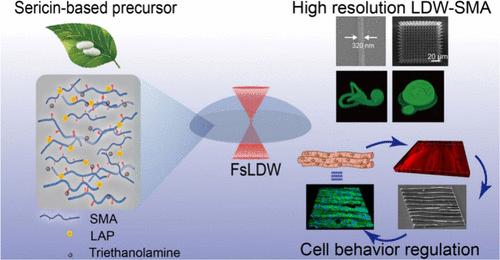利用激光直写技术制造丝胶基三维高精度仿生微支架用于组织工程
IF 9.1
1区 材料科学
Q1 CHEMISTRY, MULTIDISCIPLINARY
引用次数: 0
摘要
在组织工程中,支架被设计成模拟细胞外基质(ECM),创造支持细胞粘附和生长的三维(3D)微环境。然而,精确制造非均质ecm模拟三维微结构仍然是一个未解决的挑战。为了解决这一问题,利用飞秒激光直写(FsLDW)技术开发了高精度丝胶蛋白支架。化学修饰的丝胶蛋白在FsLDW工艺中作为单体,实现了纳米级的精度,并使任意3D丝胶蛋白微结构的制造成为可能。采用基于天然组织基质的仿生3D模型构建异质丝胶蛋白生物支架。这些各向异性支架有效地支持细胞的定向生长和分化。这一进展极大地提高了丝胶基组织工程支架的精度,能够创建异质、多功能的微环境,模拟天然ECM,以支持功能性组织发育,并解决在组织再生中准确模拟ECM微结构的挑战。本文章由计算机程序翻译,如有差异,请以英文原文为准。

Sericin-Based 3D High-Precision Biomimetic Microscaffold Fabricated by Laser Direct Writing for Tissue Engineering
In tissue engineering, scaffolds are designed to mimic the extracellular matrix (ECM), creating three-dimensional (3D) microenvironments that support cell adhesion and growth. However, the precise fabrication of heterogenenous ECM-mimicking 3D microstructures remains an unsolved challenge. To address this, high-precise sericin-based scaffolds were developed via femtosecond laser direct writing (FsLDW) technology. Chemically modified sericin served as a monomer in the FsLDW process, achieving nanoscale precision and enabling the fabrication of arbitrary 3D sericin microstructures. Biomimetic 3D models, derived from natural tissue matrices, were employed to construct heterogenenous sericin bioscaffolds. These anisotropic scaffolds effectively supported cell directional growth and differentiation. This advancement greatly enhances the precision of sericin-based tissue-engineered scaffolds, enabling the creation of heterogenenous, multifunctional microenvironments that mimic natural ECM to support functional tissue development and address challenges in accurately simulating ECM microstructures in tissue regeneration.
求助全文
通过发布文献求助,成功后即可免费获取论文全文。
去求助
来源期刊

Nano Letters
工程技术-材料科学:综合
CiteScore
16.80
自引率
2.80%
发文量
1182
审稿时长
1.4 months
期刊介绍:
Nano Letters serves as a dynamic platform for promptly disseminating original results in fundamental, applied, and emerging research across all facets of nanoscience and nanotechnology. A pivotal criterion for inclusion within Nano Letters is the convergence of at least two different areas or disciplines, ensuring a rich interdisciplinary scope. The journal is dedicated to fostering exploration in diverse areas, including:
- Experimental and theoretical findings on physical, chemical, and biological phenomena at the nanoscale
- Synthesis, characterization, and processing of organic, inorganic, polymer, and hybrid nanomaterials through physical, chemical, and biological methodologies
- Modeling and simulation of synthetic, assembly, and interaction processes
- Realization of integrated nanostructures and nano-engineered devices exhibiting advanced performance
- Applications of nanoscale materials in living and environmental systems
Nano Letters is committed to advancing and showcasing groundbreaking research that intersects various domains, fostering innovation and collaboration in the ever-evolving field of nanoscience and nanotechnology.
 求助内容:
求助内容: 应助结果提醒方式:
应助结果提醒方式:


